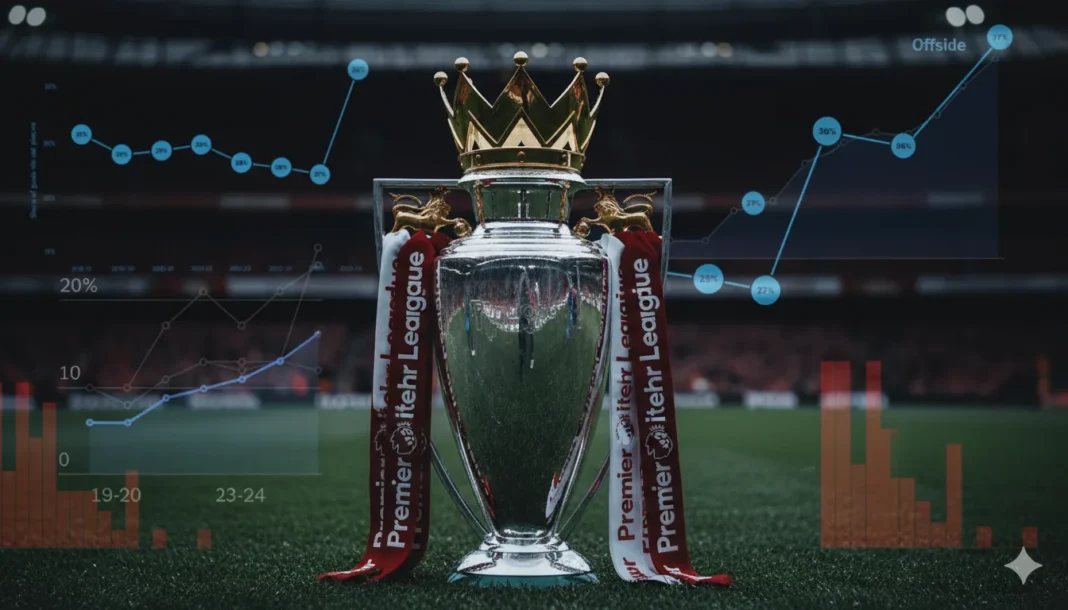There’s something delightfully obsolete about the Premier League’s current tactical landscape. While the football world has spent the last decade obsessing over gegenpressing, inverted full-backs, and false nines, the 2025-26 season has witnessed the resurgence of tactics that would feel perfectly at home in 1980s English football. Set pieces are dominating like never before. Long throws have become versatile weapons. Late goals are arriving with unprecedented frequency. The beautiful game, it seems, has rediscovered some beautifully simple truths.
The Set Piece Revolution
The numbers tell a stark story: set pieces now account for 36% of Premier League goals after six games this season, a dramatic leap from 25% at the same stage last campaign (The Athletic). One in three goals arriving from dead-ball situations represents a seismic shift in how teams are approaching chance creation (Mark Carey).

This isn’t sample-size noise or a statistical anomaly. The trend persists even when comparing season openers across multiple years, suggesting something fundamental has changed in how clubs prepare for and execute set pieces. While analysts rightly caution about drawing definitive conclusions from limited data, the evidence increasingly points toward a genuine tactical evolution rather than random fluctuation.
Part of the explanation lies in physicality. Teams across the division have become more athletic, more organised, and better equipped to exploit aerial situations. Historically, set-piece success suffered from survivorship bias; only already dominant teams, such as Manchester City or Liverpool, excelled because they possessed the personnel and coaching infrastructure that others lacked.
That’s no longer true. League-wide recruitment has elevated physical standards, while the rise of specialist set-piece coaches has democratised tactical sophistication (Recent example- Nicolas Jover from Arsenal). These coaches bring creative choreographies that transform routine corners into elaborately designed attacking sequences. Their impact may have lagged, many were hired in recent years, but results are surfacing dramatically now.
Promoted sides provide the clearest evidence of this trend. Clubs like Leeds United study Premier League survival patterns obsessively, identifying set-piece proficiency and physical dominance as crucial differentiators between staying up and going down. Their tactics match their player profiles: physical, aggressive out-of-possession play that helps both defending and attacking dead balls.
The Long Throw Rebirth
Perhaps nothing epitomises this old-school revival more than the long throw’s remarkable comeback. Every single Premier League team has attempted a long box throw into the final third this season. Only three clubs- Manchester City, Aston Villa, and Nottingham Forest have failed to generate a shot from this scenario.
Opta’s Long Throw definition: Throws-ins taken in the final third which travel over 20 metres and end in the opposition’s box.
The statistics are extraordinary: over 26% of all final-third throws now enter the penalty area, compared to roughly 11% in previous seasons (The Athletic). That’s not marginal improvement; it’s fundamental tactical reorientation.

These throws are no longer desperate attempts into the mixer. They’re treated like structured set plays, comparable to wide free kicks or corners, with teams sending defenders forward and executing choreographed routines. Crystal Palace’s routine against Aston Villa and Brentford’s sequence against Chelsea both produced goals directly from long-throw situations.
Expected goals analysis reveals why this approach works: long throws create valuable second-phase opportunities even when direct shots don’t materialise. The initial delivery disrupts defensive organisation, and the subsequent chaos in the box frequently produces high-quality chances.

The tactical logic is tempting. Long throws can be generated from more positions than corners, allowing teams to repeat these set pieces from higher up the pitch. Promoted teams particularly benefit from corners, which require territorial dominance that weaker sides struggle to establish, but long throws are accessible to everyone. It’s chance creation democratised, allowing underdogs to compete with elite opposition through physicality and organisation rather than technical superiority.
Arsenal’s Set Piece Mastery
Arsenal’s strength at set pieces isn’t just about clever routines or towering players; it’s about where they choose to play the game. By dominating territory and keeping the ball deep in their opponent’s half, they create far more chances to swing in a corner or line up a free kick than anyone else in the league.
A key point here is field tilt– the share of touches a team makes in the attacking third. The higher it is, the more likely a side is to generate shots and goals from corners. Arsenal’s high-field tilt is no accident; it comes from sustained possession and relentless pressing that pins opponents back, forcing hurried clearances and mistakes.

Their set-piece danger is the product of a two-pronged strategy. First, they pile on open-play pressure until defences crack. Then, when those cracks lead to a corner or free kick in a dangerous area, eventually this is when Arsenal strike. This cycle keeps the opposition under siege: territorial dominance creates set-piece chances, and set pieces in turn fuel more dominance.
Late Goals and Tactical Fatigue
The Premier League recently set a record for stoppage-time goals scored in a single matchday, part of a broader trend toward late decisive moments. Again, this isn’t random, it’s the predictable consequence of tactical and regulatory changes colliding.

Historically, the late 1980s through 2000s saw teams favour zonal marking and defending deeper, surrendering territory while controlling space. This benefited possession-dominant sides more likely to break down low blocks in the match’s closing stages.
More recently, teams adopted man-marking and high-pressing schemes to disrupt build-up play higher up the pitch. This approach is high-intensity and extraordinarily difficult to sustain for ninety minutes. As players tire, teams inevitably revert to deeper blocks, giving away chances to elite opposition who exploit exhausted defences in dying minutes.
The five-substitution rule, made permanent in 2022-23, amplifies this effect. Top teams can now maintain intensity with high-quality replacements, particularly in the closing stages when opponents are visibly fatigued. Combined with matches regularly running close to 100 minutes, there’s simply more opportunity for late drama.
Competitive balance still leans late games toward stronger teams. Weaker sides can compete for an hour through tight organization and work rate, but physical and mental fatigue eventually creates gaps that superior talent exploits ruthlessly.
The Offside Question
One of the season’s most surprising statistical trends is the dramatic decline in offside calls. The numbers have swooped compared to previous campaigns, a shift with multiple explanations.
Semi-automated offside technology, introduced league-wide after trials last season, has changed player behaviour. Attackers are timing runs more cautiously, starting a yard deeper to avoid marginal calls. The technology’s precision means fewer borderline decisions go in the attacker’s favour, resulting in conservative positioning.

Tactically, teams are completing fewer through balls, just 77 so far, compared to well over 100 at this stage in prior seasons (The Athletic). Defensive lines have become more aggressive in initial pressing phases, leaving less space for patient through-ball play out of the back. The emphasis has shifted toward more direct, vertical play and counter-attacks, reducing situations where tight offside traps come into play.
The High Line Gamble
Manchester City and Barcelona remain the “poster boys” for aggressive high defensive lines. Barcelona have forced 213 offsides since last season, far exceeding Valencia’s second-place total of 130 in La Liga. That’s not just impressive; it’s almost absurd.
| Sr. No. | Opponent | Offside Against |
| 1 | Barcelona | 213 |
| 2 | Valencia | 130 |
| 3 | Athletic Club | 115 |
| 4 | Real Betis | 113 |
| 5 | Osasuna | 111 |
High lines compact the field vertically, allowing teams to press aggressively and control midfield zones. But the risk is substantial: one well-timed run or clever wide pass can expose defenders catastrophically. PSG’s late winner against Barcelona in the Champions League showcased precisely this vulnerability.
The tactical principle is sound but unforgiving: attacking teams only need to be right once, but defensive teams must be perfect every time. Only clubs with elite defenders capable of recovering at pace can consistently deploy this approach. Liverpool abandoned their high line when Virgil van Dijk was injured, recognising they lacked the personnel to execute it safely.
So Basically
The Premier League’s tactical landscape has become fascinatingly contradictory, simultaneously more sophisticated and more elementary than ever. Teams employ cutting-edge analytics to optimise bygone tactics like long throws and set pieces. They press with modern intensity but revert to old-fashioned deep blocks when exhausted.

This blend of classical and contemporary represents football’s perpetual evolution: tactics never truly disappear, they simply hibernate until circumstances make them relevant again. Set pieces have always mattered; teams are just finally treating them with appropriate seriousness. Long throws never stopped working; coaches simply forgot to use them.
The lesson? Innovation often means rediscovering forgotten wisdom rather than inventing something entirely new. The Premier League’s old-school revolution isn’t backward- it’s football coming full circle.


